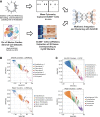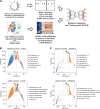Development and characterization of a mass cytometry panel for detecting the effect of acute doxorubicin exposure on murine cardiac nonmyocytes
- PMID: 35657614
- PMCID: PMC9236860
- DOI: 10.1152/ajpheart.00514.2021
Development and characterization of a mass cytometry panel for detecting the effect of acute doxorubicin exposure on murine cardiac nonmyocytes
Abstract
Childhood cancer survivors (CCSs) face lifelong side effects related to their treatment with chemotherapy. Anthracycline agents, such as doxorubicin (DOX), are important in the treatment of childhood cancers but are associated with cardiotoxicity. Cardiac toxicities represent a significant source of chronic disability that cancer survivors face; despite this, the chronic cardiotoxicity phenotype and how it relates to acute toxicity remains poorly defined. To address this critical knowledge gap, we studied the acute effect of DOX on murine cardiac nonmyocytes in vivo. Determination of the acute cellular effects of DOX on nonmyocytes, a cell pool with finite replicative capacity, provides a basis for understanding the pathogenesis of the chronic heart disease that CCSs face. To investigate the acute cellular effects of DOX, we present single-cell RNA sequencing (scRNAseq) data from homeostatic cardiac nonmyocytes and compare it with preexisting datasets, as well as a novel CyTOF datasets. SCANPY, a python-based single-cell analysis, was used to assess the heterogeneity of cells detected in scRNAseq and CyTOF. To further assist in CyTOF data annotation, joint analyses of scRNAseq and CyTOF data using an artificial neural network known as sparse autoencoder for clustering, imputation, and embedding (SAUCIE) are performed. Lastly, the panel is tested on a mouse model of acute DOX exposure at two time points (24 and 72 h) after the last dose of doxorubicin and examined with joint clustering. In sum, we report the first ever CyTOF study of cardiac nonmyocytes and characterize the effect of acute DOX exposure with scRNAseq and CyTOF.NEW & NOTEWORTHY We describe the first mass cytometry studies of murine cardiac nonmyocytes. The mass cytometry panel is compared with single-cell RNA sequencing data. Homeostatic cardiac nonmyocytes are characterized by mass cytometry to identify and quantify four major cell populations: endothelial cells, fibroblasts, leukocytes, and pericytes. The single-cell acute nonmyocyte response to doxorubicin is studied at 24 and 72 h after doxorubicin exposure given daily for 5 days at a dose of 4 mg/kg/day.
Keywords: anthracyclines; cardiotoxicity; nonmyocytes; single cell.
Conflict of interest statement
No conflicts of interest, financial or otherwise, are declared by the authors.
Figures







Similar articles
-
Plasmatic and chamber-specific modulation of cardiac microRNAs in an acute model of DOX-induced cardiotoxicity.Biomed Pharmacother. 2019 Feb;110:1-8. doi: 10.1016/j.biopha.2018.11.042. Epub 2018 Nov 16. Biomed Pharmacother. 2019. PMID: 30453253
-
Differential impact of doxorubicin dose on cell death and autophagy pathways during acute cardiotoxicity.Toxicol Appl Pharmacol. 2022 Oct 15;453:116210. doi: 10.1016/j.taap.2022.116210. Epub 2022 Aug 24. Toxicol Appl Pharmacol. 2022. PMID: 36028075
-
Ventricular nonmyocytes inhibit doxorubicin-induced myocyte apoptosis: involvement of endogenous endothelin-1 as a paracrine factor.Endocrinology. 2004 May;145(5):2458-66. doi: 10.1210/en.2003-1322. Epub 2004 Jan 21. Endocrinology. 2004. PMID: 14736733
-
Pathways of cardiac toxicity: comparison between chemotherapeutic drugs doxorubicin and mitoxantrone.Arch Toxicol. 2016 Sep;90(9):2063-2076. doi: 10.1007/s00204-016-1759-y. Epub 2016 Jun 25. Arch Toxicol. 2016. PMID: 27342245 Review.
-
Teaching the basics of the mechanism of doxorubicin-induced cardiotoxicity: Have we been barking up the wrong tree?Redox Biol. 2020 Jan;29:101394. doi: 10.1016/j.redox.2019.101394. Epub 2019 Nov 26. Redox Biol. 2020. PMID: 31790851 Free PMC article. Review.
References
-
- Armenian SH, Armstrong GT, Aune G, Chow EJ, Ehrhardt MJ, Ky B, Moslehi J, Mulrooney DA, Nathan PC, Ryan TD, van der Pal HJ, van Dalen EC, Kremer LCM. Cardiovascular disease in survivors of childhood cancer: insights into epidemiology, pathophysiology, and prevention. J Clin Oncol 36: 2135–2144, 2018. doi:10.1200/jco.2017.76.3920. - DOI - PMC - PubMed
-
- Bhakta N, Liu Q, Ness KK, Baassiri M, Eissa H, Yeo F, Chemaitilly W, Ehrhardt MJ, Bass J, Bishop MW, Shelton K, Lu L, Huang S, Li Z, Caron E, Lanctot J, Howell C, Folse T, Joshi V, Green DM, Mulrooney DA, Armstrong GT, Krull KR, Brinkman TM, Khan RB, Srivastava DK, Hudson MM, Yasui Y, Robison LL. The cumulative burden of surviving childhood cancer: an initial report from the St Jude Lifetime Cohort Study (SJLIFE). Lancet 390: 2569–2582, 2017. doi:10.1016/s0140-6736(17)31610-0. - DOI - PMC - PubMed
Publication types
MeSH terms
Substances
Grants and funding
LinkOut - more resources
Full Text Sources
Molecular Biology Databases
Miscellaneous

